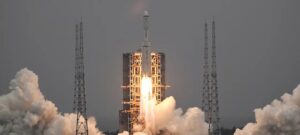 China has taken a significant step in its lunar exploration ambitions by launching a second relay satellite named “Queqiao-2” into space.
China has taken a significant step in its lunar exploration ambitions by launching a second relay satellite named “Queqiao-2” into space.
China Launches Satellites for Moon Program into Space
China is preparing to explore the far side of the moon – however, communication with probes there is challenging. Therefore, the China National Space Administration (CNSA) has launched a second relay satellite into space.
China has sent a satellite crucial for future moon missions into orbit. A Long March-8 Y carrier rocket lifted off from the spaceport on Hainan Island in southern China with the relay satellite “Queqiao-2,” as reported by Xinhua news agency. According to CNSA, the Chinese space agency, the satellite is intended to facilitate communication for upcoming lunar missions.
China plans to soon land a probe on the moon’s south side to collect soil samples. “Queqiao-2” is expected to assist in ensuring communication on the far side of the moon during this endeavor.
In 2019, the People’s Republic successfully landed the “Chang’e-4” probe on the moon and had previously launched the first “Queqiao” relay satellite into space, through which the spacecraft later transmitted images back to Earth. The relay satellite forms a communication triangle, enabling the control center on Earth to send signals to the far side of the moon.
The Moon’s Increasing Significance
By 2030, the Communist Party aims to achieve the People’s Republic’s first manned moon mission. However, the Chinese space program recently faced a setback when the Chinese satellites “DRO-A” and “DRO-B” missed their intended orbit after launch last week.
The moon was not a priority for the major space-faring nations for a long time. However, this has changed – the Chinese moon exploration program competes with those of the USA, Japan, and India.




























































